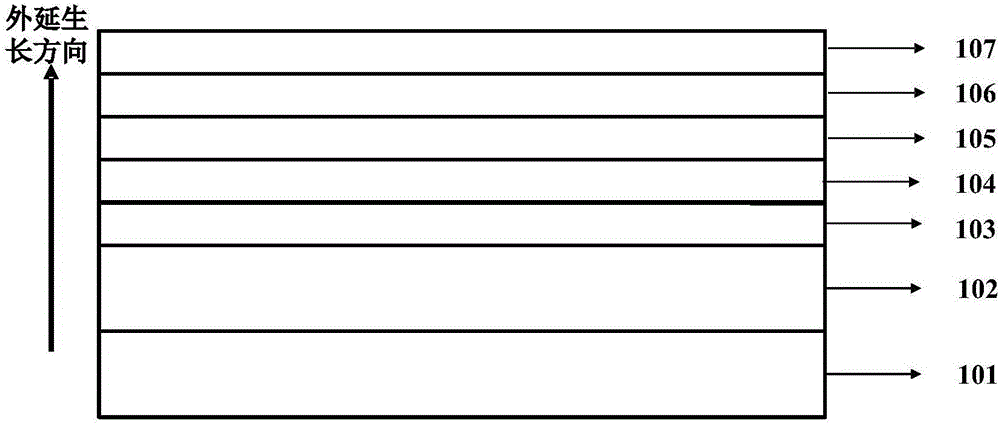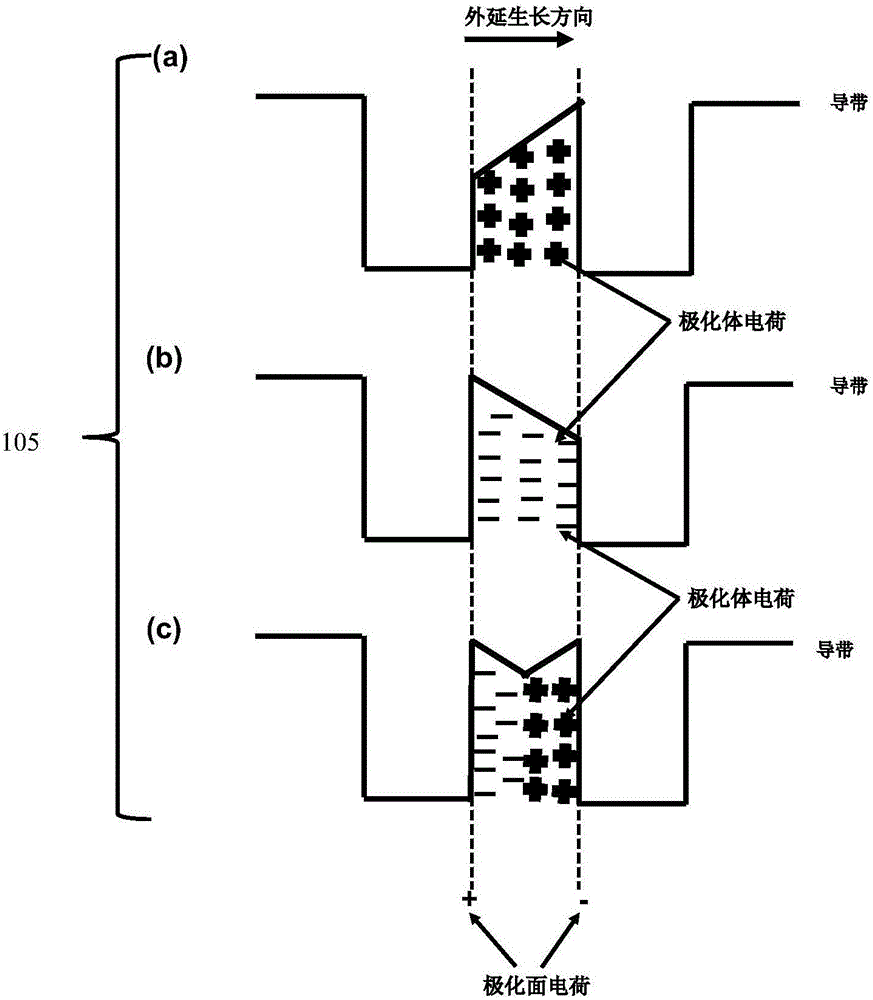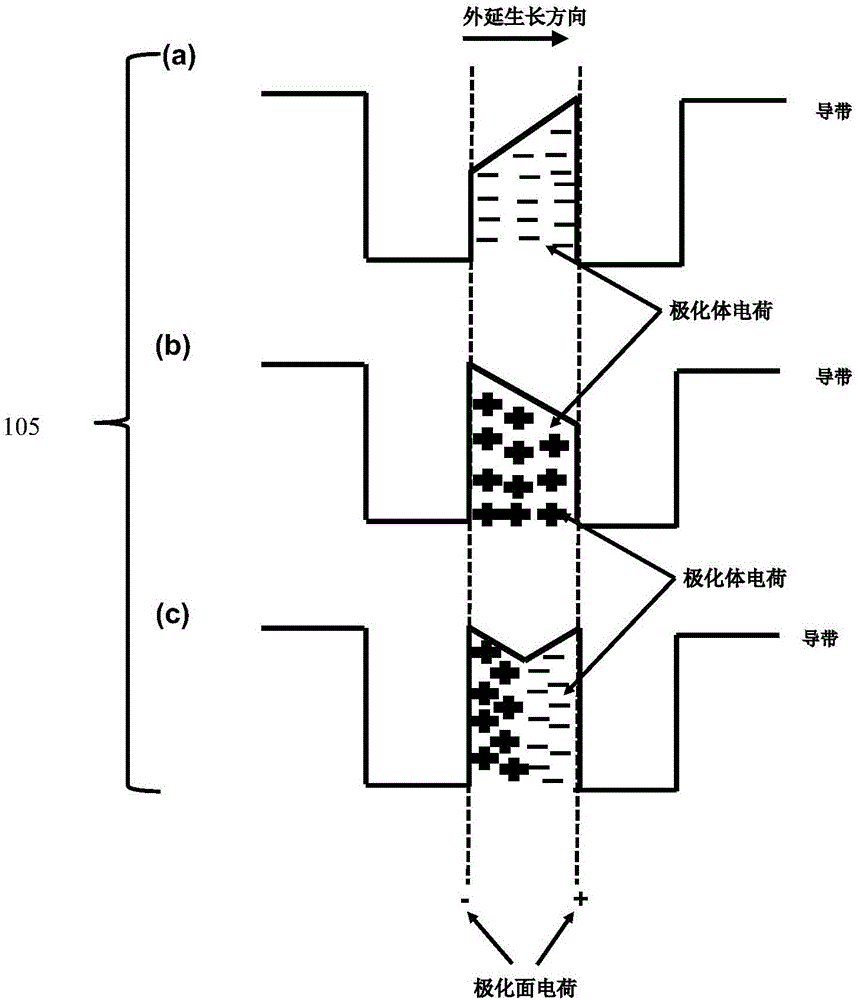Light emitting diode epitaxial structure capable of shielding quantum well region polarized field effect
A technology of light-emitting diodes and epitaxial structures, applied to electrical components, circuits, semiconductor devices, etc., can solve problems such as insignificant effects, complex processes, and affecting hole transport, and achieve the effects of improving transport efficiency and internal quantum efficiency
- Summary
- Abstract
- Description
- Claims
- Application Information
AI Technical Summary
Problems solved by technology
Method used
Image
Examples
Embodiment 1
[0048] A light-emitting diode epitaxial structure shielding the polarization field effect in the quantum well of this embodiment is arranged sequentially from bottom to top: a substrate 101, a buffer layer 102, a non-doped semiconductor material layer 103, and a doped N-type semiconductor material layer 104, multi-quantum well layer 105, P-type electron blocking layer 106 and P-type semiconductor material 107; the material of the multi-quantum well layer 105 is Al 0.9 Ga 0.1 N / Al x2 Ga 1-x2 N, in the formula, x2 shows a linear change along the growth direction of [0001] in the range of 0.9≤x2≤1, and the quantum well Al 0.9 Ga 0.1 The thickness of N is 1nm, the quantum barrier Al x2 In y2 Ga 1-x2-y2 The thickness of N is 5nm, the quantum barrier Al x2 Ga 1-x2 The minimum band gap of N is larger than that of quantum well Al 0.9 Ga 0.1 The bandgap width of N.
[0049] Among the above, the substrate 101 is sapphire; the material of the buffer layer 102 is AlN, and the t...
Embodiment 2
[0060] A light-emitting diode epitaxial structure shielding the polarization field effect in the quantum well of this embodiment, the structure is arranged from bottom to top and includes: substrate 101, buffer layer 102, non-doped semiconductor material layer 103, doped N-type Semiconductor material layer 104, multi-quantum well layer 105, P-type electron blocking layer 106 and P-type semiconductor material 107; The material of described multi-quantum well layer 105 is In 0.2 Ga 0.8 N / Al x2 Ga 1-x2 N, quantum well In 0.2 Ga 0.8 The thickness of N is 5nm, the quantum barrier Al x2 Ga 1-x2 The thickness of N is 25nm, and in the formula, x2 shows a nonlinear change along the growth direction of [000-1] in the range of 0≤x2≤1, and the quantum barrier Al x2 Ga 1-x2 The minimum band gap of N is larger than the quantum well In 0.2 Ga 0.8 The bandgap width of N.
[0061] Among the above, the substrate 101 is Si; the buffer layer 102 is made of GaN with a thickness of 30nm; ...
Embodiment 3
[0072] A light-emitting diode epitaxial structure shielding the polarization field effect in the quantum well of this embodiment, the structure is arranged from bottom to top and includes: substrate 101, buffer layer 102, non-doped semiconductor material layer 103, doped N-type Semiconductor material layer 104, multi-quantum well layer 105, P-type electron blocking layer 106 and P-type semiconductor material 107; the material of described multi-quantum well layer 105 is InN / In y2 Ga 1-y2 N, in the formula, y2 shows a combination of linear change and nonlinear change along the growth direction of [0001] in the range of 0≤y2≤1. The thickness of the quantum well InN is 20nm, and the quantum barrier InN y2 Ga 1-y2 The thickness of N is 50nm, the quantum barrier In y2 Ga 1-y2 The minimum band gap of N is larger than that of the quantum well InN.
[0073] Among the above, the substrate 101 is SiC; the material of the buffer layer 102 is InN, and the thickness is 50nm; the materi...
PUM
 Login to View More
Login to View More Abstract
Description
Claims
Application Information
 Login to View More
Login to View More - R&D
- Intellectual Property
- Life Sciences
- Materials
- Tech Scout
- Unparalleled Data Quality
- Higher Quality Content
- 60% Fewer Hallucinations
Browse by: Latest US Patents, China's latest patents, Technical Efficacy Thesaurus, Application Domain, Technology Topic, Popular Technical Reports.
© 2025 PatSnap. All rights reserved.Legal|Privacy policy|Modern Slavery Act Transparency Statement|Sitemap|About US| Contact US: help@patsnap.com



